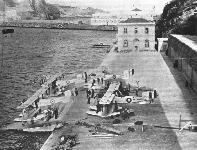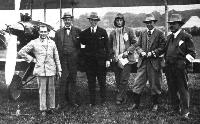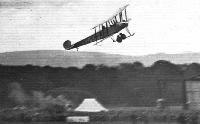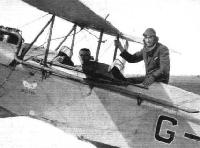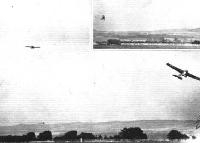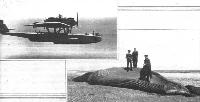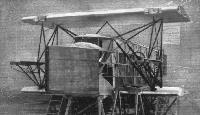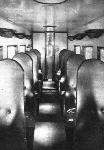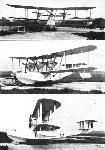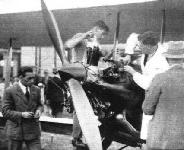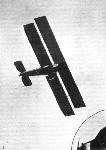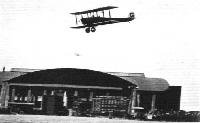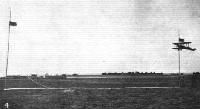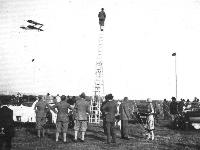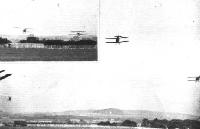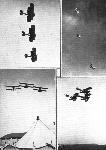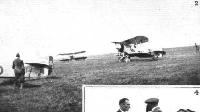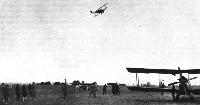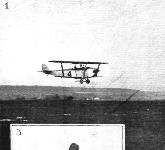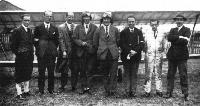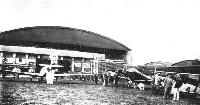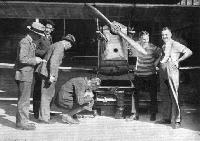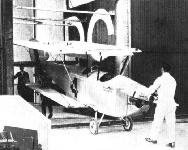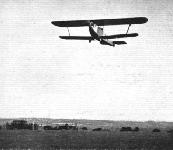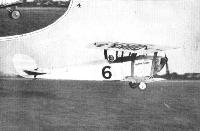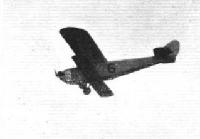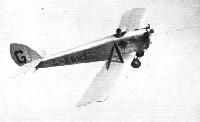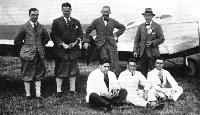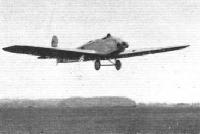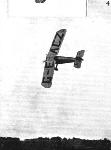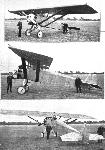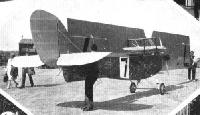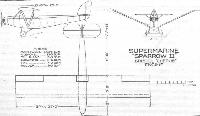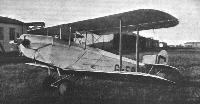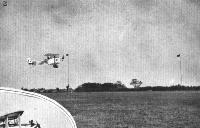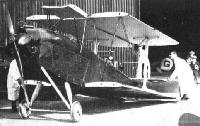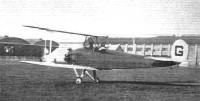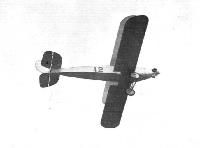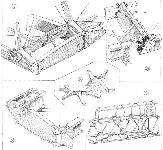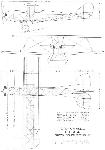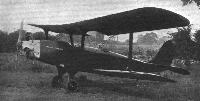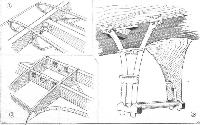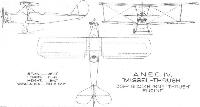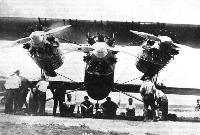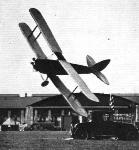Фотографии
-
CAPE FLIERS AT NAPLES: This photograph shows the four Napier-engined Fairey III.D seaplanes re-fuelling with "Shell" at Naples on their flight from Cairo to Lee-on-Solent recently, this being the concluding stage of the Cairo-Cape-Cairo-England flight.
Самолёты на фотографии: Fairey Fairey III - Великобритания - 1917
-
Регистрационный номер: G-EACZ [2], G-EBCA, E5956, K-135 [2] Cornering in the Lympne Open Handicap. Below the Sopwith "Swallow" piloted by Mr. Watts, and above Dr. Whitehead Reid in an S.E.5.
Самолёты на фотографии: RAF S.E.5 - Великобритания - 1916Sopwith Scooter/Swallow - Великобритания - 1918
-
FOKKERS FOR SWITZERLAND: A formation of Fokker F.III (Siddeley "Puma") commercial monoplanes, originally employed by K.L.M. on their air lines, being flown from Holland to Switzerland, where they have been put into service by the Basle Air Traffic Co., "Balair"
Самолёты на фотографии: Fokker F.III - Нидерланды - 1921
-
Регистрационный номер: G-EBPH [4] The new Avro "Alpha" engine.
Самолёты на фотографии: Avro Avro 504 - Великобритания - 1913
-
Регистрационный номер: G-EBPH [4] AN AVRO GROUP AT THE LANCASHIRE AIR PAGEANT: Left to right - Mr. Bert Hinkler, Mr. A. W. Hubble, Mr. R. J . Parrott, FIying Officer H. R. D. Waghorn (winner of the open handicap), Mr. R. H. Dobson, and Mr. John Lord.
Самолёты на фотографии: Avro Avro 504 - Великобритания - 1913
-
Регистрационный номер: G-EBPH [4] "VENI, VIDI, VICI": On its first appearance in public the new Avro "Alpha" engine in the Avro "Gosport" won the Open Handicap, piloted by Flying Officer Waghorn. The lower photograph gives a good idea of the clean lines of the nose with this engine, while the inset shows the machine in flight.
Самолёты на фотографии: Avro Avro 504 - Великобритания - 1913
-
Регистрационный номер: G-EBPH [4] At the Lancashire Air Pageant: Flying Officer Waghorn winning the Open Handicap on the Avro "Alpha-Gosport."
Самолёты на фотографии: Avro Avro 504 - Великобритания - 1913
-
Регистрационный номер: G-EBLR, G-EBMO [2] THE LANCASHIRE AIR PAGEANT: Line-up of six "Moths" for the start of the Inter-Club Members' Race. This was won by Mr. Lacayo, on the Lancashire Aero Club's G-EBLV.
Самолёты на фотографии: De Havilland Moth / D.H.60 - Великобритания - 1925
-
Регистрационный номер: G-EBJK [2], G-EBKP [4] READY FOR BRIGHTON: Some of the machines lined up ready for the start on the first circuit on Sunday morning. On the right, the Bristol "Brownie," which was the first machine away. The other machines are the Parnall "Pixie," the Avro "Avis," and the de Havilland "Moth."
Самолёты на фотографии: Avro Avis / Type 562 - Великобритания - 1924Bristol Brownie / Type 91 - Великобритания - 1924De Havilland Moth / D.H.60 - Великобритания - 1925Parnall Pixie - Великобритания - 1923
-
SOME PERSONAL TOUCHES: Friendly Rivalry: Captain Geoffrey de Havilland takes Mr. Roy Chadwick, Avro designer, for a flight in his "Moth"
Самолёты на фотографии: De Havilland Moth / D.H.60 - Великобритания - 1925
-
Регистрационный номер: G-EBMO [2] THE LYMPNE OPEN HANDICAP: 5. The white de Havilland "Moth."
Самолёты на фотографии: De Havilland Moth / D.H.60 - Великобритания - 1925
-
Регистрационный номер: G-EBND [3] THE AVRO "AVENGER": These four views of the machine show the remarkably clean lines. The rudder, wholly above the tail, somehow gives a German appearance. In the inset Mr. Bert Hinkler "gives scale" to the nose. It should be remembered, however, that Hinkler is one of our smallest pilots in the matter of stature, though certainly not in nerve.
Самолёты на фотографии: Avro Avenger / Type 566 - Великобритания - 1926
-
Регистрационный номер: G-EBND [3] SPEED! Mr. Bert Hinkler gives a demonstration of the performance of the Avro "Avenger" with Napier engine. Figures cannot be given, but the machine is certainly extremely fast.
Самолёты на фотографии: Avro Avenger / Type 566 - Великобритания - 1926
-
Регистрационный номер: G-EBND [3] MANOEUVRABILITY: These views of the Avro "Avenger" in flight, piloted by Bert Hinkler, indicate that controllability is not lacking. The engine is a Napier.
Самолёты на фотографии: Avro Avenger / Type 566 - Великобритания - 1926
-
LINE UP FOR THE S.M.M.T. RACE: From left to right the machines are: de Havilland "Moth," Avro "Avian," Farnborough "Cygnet," Parnall "Pixie," and Bristol "Brownie." This race was won by Hinkler on the Avro "Avian," at an average speed of 90 m.p.h.
Самолёты на фотографии: Avro Avian / Type 594/616 - Великобритания - 1926Bristol Brownie / Type 91 - Великобритания - 1924De Havilland Genet Moth - Великобритания - 1926Hawker Cygnet - Великобритания - 1924Parnall Pixie - Великобритания - 1923
-
THE PARNALL TEAM: Left to right, J. Smith, J. W. Copley, H. Bolas (designer), F. Courtney (pilot), T. Healey, W. Lane, and D. Twose.
Самолёты на фотографии: Parnall Pixie - Великобритания - 1923
-
Регистрационный номер: G-EBHS, G-EBJU [2] THE RACE FOR THE GROSVENOR CHALLENGE CUP: No less than 21 machines faced the starter for this race, a record number. The result was that machines frequently got bunched together at the turning points. Our photograph show one of some such incidents. In 3 may be recognised the Short "Satellite," the Parnall "Pixie" and the R.A.E. "Hurricane."
Самолёты на фотографии: Parnall Pixie - Великобритания - 1923RAE Hurricane - Великобритания - 1923Short Satellite / S.4 - Великобритания - 1924
-
ELIMINATING TRIALS AT LYMPNE: 3, Courtney on the Parnall "Pixie III," is well above the flags.
Самолёты на фотографии: Parnall Pixie - Великобритания - 1923
-
THE FIRST OF THE ELIMINATING TESTS AT LYMPNE: Some of the competing machines photographed during the folding, housing and re-erecting test. 4, the Parnall "Pixie III"
Самолёты на фотографии: Parnall Pixie - Великобритания - 1923
-
THE TWO WHALES: A pilot of a Spanish Dornier "Wal" (Whale) flying-boat spotted a real whale during a recent flight, and, descending, pilot and crew claimed their prize. Our pictures show the "artificial" whale in the airland the real thing after capture.
Самолёты на фотографии: Dornier Do.J Wal - Германия - 1922
-
NAPIERS FOR DUTCH EAST INDIES: The machine shown above is a Fokker, type C.V., one of a batch built by the Fokker works for the Dutch East Indian Military Air Force. It is a two-seater reconnaissance biplane with Napier "Lion" engine, and is credited with a top speed of 147 m.p.h., a ceiling of 21,300 ft., and a useful load of 2,112 lb. The famous Dutch designer shows a decided preference for British aero engines.
Самолёты на фотографии: Fokker C.V / C.VI - Нидерланды - 1924
-
Регистрационный номер: L-BUCD A CZECHO-SLOVAKIAN AIR TOUR OF EUROPE: Capt. Stanovsky, the Czechoslovakian pilot, standing beside his "Aero" biplane (240 h.p., "Perun" engine) on his arrival at Croydon recently, during his aerial tour of Europe. His engineer is seen filling up with "Mobiloil."
Самолёты на фотографии: Aero A.11 - Чехословакия - 1925
-
The Albatros L.73: Three-quarter front view of the fuselage, showing centre-sections, wing-engine mountings, &c. The bracing of the top centre-section is unusual, having no struts to the front spar.
Самолёты на фотографии: Albatros L.73 - Германия - 1926
-
THE ALBATROS L.73: This new German passenger-carrier, here shown in side view, is fitted with two B.M.W. type IV engines of 230 h.p. each. The cabin has seating accommodation for 8 passengers.
Самолёты на фотографии: Albatros L.73 - Германия - 1926
-
THE ALBATROS L.73: Three-quarter rear view. It will be noted that there is no fixed vertical fin, but that the rudder has a large horn balance.
Самолёты на фотографии: Albatros L.73 - Германия - 1926
-
THE ALBATROS L.73: This view in the cabin, looking aft, shows the 8 seats. The back rests of the seats can be tilted to various angles, and for night flying every two seats make one sleeping berth, the seats being tipped up by means of handles and catches.
Самолёты на фотографии: Albatros L.73 - Германия - 1926
-
2,000 H.P.: These three photographs show the Blackburn "Iris" three-engined flying boat with Rolls-Royce "Condor III" engines.
Самолёты на фотографии: Blackburn Iris / R.B.1 - Великобритания - 1926
-
Регистрационный номер: L-BONG PRAGUE - PARIS - PRAGUE IN A LIGHT 'PLANE: Lieut. Jira, the well-known Czecho-Slovakian pilot, and the Avia B.H.9 (60 h.p. Walter engine), on which he flew from Prague to Paris and back non-stop on August 31 - a distance of 1,180 miles in 13 hrs. 43 mins.
Самолёты на фотографии: Avia BH-9 / BH-10 / BH-11 / BH-12 / BH-16 - Чехословакия - 1923
-
No. 9. THE AVRO "AVIAN": Three-quarter front view.
Самолёты на фотографии: Avro Avian / Type 594/616 - Великобритания - 1926
-
SOME PERSONAL TOUCHES: The daily toilette: Hinkler having the petrol tank of his Avro "Avis" put on board again after one of its many visits to Hythe.
Самолёты на фотографии: Avro Avian / Type 594/616 - Великобритания - 1926
-
THE LANCASHIRE AIR PAGEANT: The Avro "Avian" and the de Havilland "Moth," both with "Genet" engines, starting neck-and-neck in the Open Handicap.
Самолёты на фотографии: Avro Avian / Type 594/616 - Великобритания - 1926De Havilland Genet Moth - Великобритания - 1926
-
"BANKING ACCOUNTS" AT LYMPNE: 1 shows the Avro "Avian" in the Grosvenor Handicap.
Самолёты на фотографии: Avro Avian / Type 594/616 - Великобритания - 1926
-
MAKING BOTH ENDS MEET: The Tail and the Engine Mounting of No. 9, the Avro "Avian." The engine is an Armstrong-Siddeley "Genet."
Самолёты на фотографии: Avro Avian / Type 594/616 - Великобритания - 1926
-
Winning the S.M.M.T. Race: Hinkler on the Avro "Avian" with Armstrong-Siddeley "Genet" engine won this race at an average speed of 90 m.p.h.
Самолёты на фотографии: Avro Avian / Type 594/616 - Великобритания - 1926
-
THE TWO AVRO'S IN THE TESTS: 4, the "Avian" makes light of the take-off test, in spite of a useful load of 828 lbs.
Самолёты на фотографии: Avro Avian / Type 594/616 - Великобритания - 1926
-
No. 1. THE BLACKBURN "BLUEBIRD": Side View.
Самолёты на фотографии: Blackburn Bluebird / L.1 - Великобритания - 1924
-
ELIMINATED: The Blackburn "Bluebird" damaged slightly its undercarriage and permission to effect repairs was refused.
Самолёты на фотографии: Blackburn Bluebird / L.1 - Великобритания - 1924
-
"BLACKBIRDERS" AT THE LANCASHIRE AIR PAGEANT: Mr. B. Flinton, Squadron-Leader Longton, D.F.C., A.F.C., Mr. A. C. Thornton, designer, under Major Bumpus, of the Blackburn "Bluebird," and Mr. Norman Blackburn.
Самолёты на фотографии: Blackburn Bluebird / L.1 - Великобритания - 1924
-
"OVER THE STICKS": This photograph gives a good idea of the manner in which the take-off tests were observed. On the ladder is Major Buchanan, of the Air Ministry, while among those in the foreground may (or may not) be recognised Major Mayo, Lieut.-Col. Sir Francis McClean, and Mr. C. C. Walker. The machine "going over the top" is the Blackburn "Bluebird," piloted by Squadron-Leader Longton.
Самолёты на фотографии: Blackburn Bluebird / L.1 - Великобритания - 1924
-
Winning the Grosvenor Cup Race: Longton, on the Blackburn "Bluebird" with Armstrong-Siddeley "Genet" engine crossing the finishing line. His average speed was 84-95 m.p.h.
Самолёты на фотографии: Blackburn Bluebird / L.1 - Великобритания - 1924
-
THE RACE FOR THE GROSVENOR CHALLENGE CUP: No less than 21 machines faced the starter for this race, a record number. The result was that machines frequently got bunched together at the turning points. Our photograph show one of some such incidents. 2, shows the wing tips of the Cranwell, the Hawker "Cygnet," the Blackburn "Bluebird," and one of the D.H. "Moths" heading for the Postling turning point.
Самолёты на фотографии: Blackburn Bluebird / L.1 - Великобритания - 1924Comper Cranwell IV / CLA.4 - Великобритания - 1926De Havilland Genet Moth - Великобритания - 1926Hawker Cygnet - Великобритания - 1924
-
FORMATION FLYING EXTRAORDINARY: Daily visitors to Lympne during the light 'plane competition were "Grebes," "Woodcocks" and "Gamecocks," whose evolutions were generally admired. Our photographs show these machines in various formations.
Самолёты на фотографии: Gloster Grebe - Великобритания - 1923Hawker Woodcock - Великобритания - 1923
-
400 c.c. ONLY: The English Electric Co.'s "Wren," which in 1923 tied with the A.N.E.C. for first prize. Mileage 87-5 miles per gallon.
Самолёты на фотографии: English Electric Wren - Великобритания - 1923
-
NEWCASTLE AERO CLUB'S FIRST FLYING MEETING: Some "snaps" taken at Cramlington. Fairey "Flycatchers" from 406 Squadron (Fleet Fighter) visited the meeting and gave fine displays
Самолёты на фотографии: Fairey Flycatcher - Великобритания - 1922
-
NEWCASTLE AERO CLUB'S FIRST FLYING MEETING: Some "snaps" taken at Cramlington. Fairey "Flycatchers" from 406 Squadron (Fleet Fighter) visited the meeting and gave fine displays
Самолёты на фотографии: Fairey Flycatcher - Великобритания - 1922
-
THE WINNING SMILE: Flight-Lieut. Bulman crossing the finishing line at Lympne as winner of first prize in the "Daily Mail" light 'plane competition.
Самолёты на фотографии: Hawker Cygnet - Великобритания - 1924
-
THE RACE FOR THE GROSVENOR CHALLENGE CUP: No less than 21 machines faced the starter for this race, a record number. The result was that machines frequently got bunched together at the turning points. Our photograph show one of some such incidents. In 1 are seen the D.H. 53, the Farnborough "Cygnet," and the Cranwell biplane approaching the aerodrome turning point.
Самолёты на фотографии: Comper Cranwell IV / CLA.4 - Великобритания - 1926De Havilland Humming Bird / D.H.53 - Великобритания - 1923Hawker Cygnet - Великобритания - 1924
-
THE LYMPNE OPEN HANDICAP: 1. No. 4, the Farnborough "Cygnet," winning this event.
Самолёты на фотографии: Hawker Cygnet - Великобритания - 1924
-
THE FARNBOROUGH TEAM (Second in Competition): Left to right, E. Brame, S. O. Smith, Manning Harris, F.O. Ragg, Flight-Lieut. Chick, G. N. G. Peters, W. Baker, and the "Flying Marshal," Mr. Preston.
Самолёты на фотографии: Hawker Cygnet - Великобритания - 1924
-
AT THE SALES: Competitors waiting at the petrol "shop" to be served. On the right, in front of the Farnborough Hawker "Cygnet" may be seen Air Vice-Marshal Sir Sefton Brancker with Capt. Goodman Crouch.
Самолёты на фотографии: Hawker Cygnet - Великобритания - 1924
-
"Weighed but not found wanting": The Hawker "Cygnet" on the scales. On the right Mr. Fordham, of the Hawker Company.
Самолёты на фотографии: Hawker Cygnet - Великобритания - 1924
-
THE WINNING SMILE: A group of "Hawkers" in front of the winning "Cygnet." Left to right : Mr. F. Sigrist, Mr. Hayward, Lieut. Bulman, Mr. Peaty, Mrs. Bulman and Mr. Jones.
Самолёты на фотографии: Hawker Cygnet - Великобритания - 1924
-
THE FIRST OF THE ELIMINATING TESTS AT LYMPNE: Some of the competing machines photographed during the folding, housing and re-erecting test. 2, the Farnborough Hawker "Cygnet."
Самолёты на фотографии: Hawker Cygnet - Великобритания - 1924
-
When Old Mother Swan wasn't looking. No. 6, the Hawker "Cygnet" doing a bit of "stunting."
Самолёты на фотографии: Hawker Cygnet - Великобритания - 1924
-
THE START OF THE COMPETITION: Some of the competing machines on Sunday morning at the start for Brighton. 3, Chick on the Farnborough Hawker "Cygnet" gets away well.
Самолёты на фотографии: Hawker Cygnet - Великобритания - 1924
-
Регистрационный номер: G-EBMB [2] THE LYMPNE OPEN HANDICAP: 3. The Hawker "Cygnet" trying to beat its handicap
Самолёты на фотографии: Hawker Cygnet - Великобритания - 1924
-
The shortest pull-up in 1924 was scored by Longton on the Hawker "Cygnet," with Anzani engine.
The Light 'Plane Competition, Lympne: Longton on No. 14, the Hawker biplane, "Cygnet," landing after the first circuit in the eliminating trials.Самолёты на фотографии: Hawker Cygnet - Великобритания - 1924
-
THE WINNING SMILE: The Hawker "Cygnet" is seen coming to rest, while admirers run out to congratulate "George" on his success.
Самолёты на фотографии: Hawker Cygnet - Великобритания - 1924
-
Регистрационный номер: G-EBMB [2] ELIMINATING TRIALS AT LYMPNE: 4, a "close-up" of Bulman landing the Hawker "Cygnet."
Самолёты на фотографии: Hawker Cygnet - Великобритания - 1924
-
THE START OF THE COMPETITION: Some of the competing machines on Sunday morning at the start for Brighton. 4, Bulman on the Hawker "Cygnet" is first man home in the first circuit. The best fuel consumption on this circuit was scored by Bulman.
Самолёты на фотографии: Hawker Cygnet - Великобритания - 1924
-
Регистрационный номер: G-EBHZ A very fine little Machine: The de Havilland 53 belonging to the Seven Aeroplane Club flies like a small Scout in spite of the fact that its engine is an A.B.C. of some 35 h.p. only.
Самолёты на фотографии: De Havilland Humming Bird / D.H.53 - Великобритания - 1923
-
THE BRISTOL TEAM: From left to right, standing, P. Mayer, R. Fedden, F. Uwins, and A. Suddes. Seated, W. Allen, F. Chard, and F. Godfrey.
Самолёты на фотографии: Bristol Brownie / Type 91 - Великобритания - 1924
-
Регистрационный номер: G-EBJK [2] No. 3. The "Bristol Brownie," with Bristol "Cherub" Engine: Side view. Note the addition of a deck fairing on top of fuselage.
Самолёты на фотографии: Bristol Brownie / Type 91 - Великобритания - 1924
-
THE START OF THE COMPETITION: Some of the competing machines on Sunday morning at the start for Brighton. 1, Uwins on the Bristol "Brownie" was the first man away.
Самолёты на фотографии: Bristol Brownie / Type 91 - Великобритания - 1924
-
Регистрационный номер: G-EBJM THE LYMPNE OPEN HANDICAP: 2. The single-seater Bristol "Brownie" in a sharp turn.
Самолёты на фотографии: Bristol Brownie / Type 91 - Великобритания - 1924
-
Регистрационный номер: G-EBMJ [2] A Seaplane on Wheels: The Short "Mussel" has been fitted with a land undercarriage and took part in Saturday's racing.
Самолёты на фотографии: Short Mussel / S.7 - Великобритания - 1926
-
Регистрационный номер: G-EBMJ [2] "BANKING ACCOUNTS" AT LYMPNE: 2. Mr. Lankester Parker stands the Short "Mussel" on its wing tip in the Grosvenor Handicap.
Самолёты на фотографии: Short Mussel / S.7 - Великобритания - 1926
-
Halton H.A.C.1 Bristol "Cherub" Engine
Самолёты на фотографии: Halton H.A.C.1 Mayfly/H.A.C.2 Minus - Великобритания - 1927
-
Регистрационный номер: G-EACZ [2], K-135 [2] THE LYMPNE OPEN HANDICAP: 4, The Sopwith "Swallow" wanting to know "Watts what."
Самолёты на фотографии: Sopwith Scooter/Swallow - Великобритания - 1918
-
ALL-METAL CONSTRUCTION AT WEYBRIDGE: Three views of one of the batch of Vickers-"Wibault" single-seater fighters which Vickers, Limited, are building at their Weybridge works. These machines are built almost entirely of Vickers Duralumin, even the covering being of this material. The engines fitted are Bristol "Jupiters."
Самолёты на фотографии: Wibault Wib.3 / Wib.7 - Франция - 1923
-
QUANTITY PRODUCTION OF ALL-METAL AEROPLANES: A batch of Wibault scouts in course of construction at'the Weybridge works of Vickers, Ltd. The Wibault is of French design, Vickers holding the British rights. The engines fitted are Bristol "Jupiters."
Самолёты на фотографии: Wibault Wib.3 / Wib.7 - Франция - 1923
-
An Aerial Show-Room for Motor Cars: Our picture shows an interior view of the cabin of the American Remington Burnelli "RB2" air liner fitted up as a motor-car showroom, complete with an Essex motor-car, and office equipment. So fitted, it carried out an aerial tour, with eight passengers, in the States. The fuselage of the "RB2," it may be mentioned, is exceptionally wide and deep, forming, in side elevation, the contour of an aerofoil.
Самолёты на фотографии: Burnelli RB-1 / RB-2 - США - 1921
-
A 1923 WINNER: The A.N.E.C. with Blackburne Engine which tied with the "Wren" for first prize. 87-5 miles per gallon. James wheeling his machine out before a flight, and, inset, a typically banked turn.
Самолёты на фотографии: ANEC I / II - Великобритания - 1923
-
Регистрационный номер: J7322 1,000 MILES AROUND LYMPNE: Mr. Bert Hinkler in his Avro monoplane, 700 c.c. Blackburne engine, at the completion of his 80 laps of the course. Inset, the machine crossing the finishing line at the end of the 80th lap. During the whole week Hinkler did not have a single forced landing.
Самолёты на фотографии: Avro Type 560 - Великобритания - 1923
-
Регистрационный номер: G-EBJU [2] No.15. THE SHORT "SATELLITE": This machine has been entered by the Seven Aeroplane Club.
Самолёты на фотографии: Short Satellite / S.4 - Великобритания - 1924
-
Регистрационный номер: G-EBJP [2] No. 7. THE SUPERMARINE "SPARROW II": Three-quarter front view. Note the square wing tips.
Самолёты на фотографии: Supermarine Sparrow - Великобритания - 1924
-
Регистрационный номер: G-EBJP [2] THE FIRST OF THE ELIMINATING TESTS AT LYMPNE: Some of the competing machines photographed during the folding, housing and re-erecting test. 3, the Supermarine "Sparrow II" which has its wings in one piece and must be transported as shown.
Самолёты на фотографии: Supermarine Sparrow - Великобритания - 1924
-
Supermarine "Sparrow II" Bristol "Cherub" Engine
Самолёты на фотографии: Supermarine Sparrow - Великобритания - 1924
-
Регистрационный номер: G-EBJV No.16. THE WESTLAND "WOODPIGEON": This machine has been entered by the Seven Aeroplane Club.
Самолёты на фотографии: Westland Wood Pigeon - Великобритания - 1924
-
ELIMINATING TRIALS AT LYMPNE: 2, the Westland "Woodpigeon" during a take-off attempt.
Самолёты на фотографии: Westland Wood Pigeon - Великобритания - 1924
-
Регистрационный номер: G-EBJJ, VH-URJ THE 1924 WINNER: The Beardmore "Wee Bee," with Bristol "Cherub," which, piloted by Maurice Piercey, gained first prize.
Самолёты на фотографии: Beardmore W.B.XXIV Wee Bee - Великобритания - 1924
-
GREATEST MILEAGE IN 1924: 762-5 miles were flown by the Cranwell C.L.A.2, piloted by Lieut. N. Comper, its designer. The engine fitted was a Bristol "Cherub."
Самолёты на фотографии: Comper Cranwell II / CLA.2 - Великобритания - 1924
-
Регистрационный номер: G-EBKP [4] THE FIRST OF THE ELIMINATING TESTS AT LYMPNE: Some of the competing machines photographed during the folding, housing and re-erecting test. 1, the Avro "Avis."
Самолёты на фотографии: Avro Avis / Type 562 - Великобритания - 1924
-
Регистрационный номер: G-EBKP [4] No. 10. THE AVRO "AVIS": Three-quarter front view.
Самолёты на фотографии: Avro Avis / Type 562 - Великобритания - 1924
-
Регистрационный номер: G-EBKP [4] THE TWO AVRO'S IN THE TESTS: 2, Douglas away on the "Avis" on Sunday morning. This machine has since been eliminated by a damaged undercarriage.
Самолёты на фотографии: Avro Avis / Type 562 - Великобритания - 1924
-
Регистрационный номер: G-EBOJ THE LANCASHIRE AIR PAGEANT: Captain Courtney on the A.D.C. Nimbus-Martinsyde starts scratch in the Open Handicap.
Самолёты на фотографии: Martinsyde A.D.C.1 / Nimbus - Великобритания - 1924
-
No. 12. THE CRANWELL C.L.A.4: Front view. Note the short top plane
Самолёты на фотографии: Comper Cranwell IV / CLA.4 - Великобритания - 1926
-
One of the "Eliminated": The Cranwell C.L.A.4 biplane damaged an undercarriage and was refused permission to repair. It is therefore out of the competition.
Самолёты на фотографии: Comper Cranwell IV / CLA.4 - Великобритания - 1926
-
No. 12. THE CRANWELL C.L.A.4: Three-quarter rear view.
Самолёты на фотографии: Comper Cranwell IV / CLA.4 - Великобритания - 1926
-
THE CRANWELL TEAM: Left to right, Flight-Sergt. Hammond, Flight-Sergt. McKeown, F.O. Cashmore, Flight-Lieut. Pack, Flight-Lieut. Comper (designer and pilot), Flight-Lieut. Walmesley, (pilot), Flight-Lieut. George, and F. O. Herbert.
Самолёты на фотографии: Comper Cranwell IV / CLA.4 - Великобритания - 1926
-
"BANKING ACCOUNTS" AT LYMPNE: 5. Lieut. Walmesley rounding the aerodrome turning point on the Cranwell biplane.
Самолёты на фотографии: Comper Cranwell IV / CLA.4 - Великобритания - 1926
-
THE CRANWELL C.L.A. IV: Some constructional details: 1, The lower plane wing roots built into the fuselage. The bottom longeron is shown broken away behind the rear spar so as to show better the metal fitting, and between the spars this longeron passes just inside the inner rib. The rear undercarriage strut is attached to the front spar attachment. The hinges for folding the wings are also shown. In 2 is illustrated the inner end of the starboard lower plane, with hinge fittings, etc. The solid rib is partly broken away to show the form of the drag bracing clip. 3 illustrates the special rib and sheet steel fittings for the inter-plane I-strut on the lower plane. This strut slopes inwards, the sketch being viewed from outside the strut attachment. The spar is broken away to show the details of the special metal fitting for the attachment of the strut. The form of construction employed in the rear portion of the fuselage is illustrated in 4, while 5 shows details of this construction, the actual joint shown being on the lower longeron and viewed from inside.
Самолёты на фотографии: Comper Cranwell IV / CLA.4 - Великобритания - 1926
-
Cranwell C.L.A.4 Bristol "Cherub" Engine
Самолёты на фотографии: Comper Cranwell IV / CLA.4 - Великобритания - 1926
-
Регистрационный номер: G-EBPI No. 13. A.N.E.C. IV "Missel Thrush": Three-quarter front view.
Самолёты на фотографии: ANEC IV Missel Thrush - Великобритания - 1926
-
THE A.N.E.C. IV "MISSEL THRUSH." SOME CONSTRUCTIONAL DETAILS :- (1) Shows the simple wing construction at the interplane strut-compression member section ; the leading edge is an aluminium tube, while the spar is of the box type, spruce and plywood. (2) Is the centre of the tail plane, which "sits" on the flat upper surface of the fuselage, and is held down by four long bolts passing from the latter through the fittings on the tail spars. Note, on the rear spar, the neat roller for the control cables. (3) The chassis struts, comprising steel tubes, forming a curved Vee, and connected at the ends by a streamline "trough" carrying the axle, are faired as shown by plywood.
Самолёты на фотографии: ANEC IV Missel Thrush - Великобритания - 1926
-
A.N.E.C. IV "Missel Thrush" 35 hp. Blackburne "Thrush" Engine
Самолёты на фотографии: ANEC IV Missel Thrush - Великобритания - 1926
-
A BRISTOL WIN IN AMERICA: The Heath "Tomboy" light monoplane, fitted with a Bristol "Cherub" engine, which won the "Dayton Daily News" Trophy, one of the Light 'Plane events in the National Air Races at Philadelphia on September 7.
Самолёты на фотографии: Heath Tomboy - США - 1926
-
THE SIKORSKY S.35 3-ENGINED BIPLANE: The three engines fitted to this machine are 400-h.p. Gnome-Rhone "Jupiter" air-cooled radials, built in France under licence from the Bristol Co.
Самолёты на фотографии: Sikorsky S-35 - США - 1926
-
The partially finished fuselage of the Sikorsky S.35 3-engined biplane. In this duralumin tubes of square section are mainly employed.
Самолёты на фотографии: Sikorsky S-35 - США - 1926
-
THE SIKORSKY S.35 3-ENGINED BIPLANE: Preparing for the Atlantic flight; a general view of Capt. Fonck's machine at Roosevelt Field, New York.
Самолёты на фотографии: Sikorsky S-35 - США - 1926
-
Sikorsky S.35 3 Jupiter Engines
Самолёты на фотографии: Sikorsky S-35 - США - 1926
-
THE DE HAVILLAND TEAM: From left to right, H. Cantrill, R. Brant, E. Mitchell, Capt. de Havilland, W. Hales (Armstrong-Siddeley), and Capt. H. Broad.
Самолёты на фотографии: De Havilland Genet Moth - Великобритания - 1926
-
Capt. Broad cornering on the de Havilland "Moth" with "Genet" engine in the S.M.M.T. Race. Average speed 94-75 m.p.h.
Самолёты на фотографии: De Havilland Genet Moth - Великобритания - 1926
-
ELIMINATING TRIALS: In the lower photograph the de Havilland "Moth" is seen doing its get-off test, while on the right the same machine is seen in the landing test. Note the mechanic standing up to act as "air brake."
Самолёты на фотографии: De Havilland Genet Moth - Великобритания - 1926
-
No. 2. THE DE HAVILLAND "MOTH": Three-quarter front view.
Самолёты на фотографии: De Havilland Genet Moth - Великобритания - 1926
-
Making Quite Sure: Professor Low sealing the tank of the de Havilland "Moth."
Самолёты на фотографии: De Havilland Genet Moth - Великобритания - 1926
-
No. 2. THE DE HAVILLAND "MOTH": Side view.
Самолёты на фотографии: De Havilland Genet Moth - Великобритания - 1926
Статьи
- Flight
